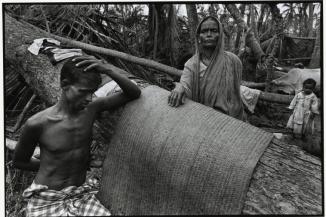
‘Goats grazing on the
Maidan.’ Thus began the essay “
The unintended city” by Jai Sen, written in 1976.
In this essay, Sen argued that hidden within the commonly perceived ‘respectable’ city, of wealth, institutions, planned improvements, intellect and culture, was another city, an unintended one, of the laboring poor. This city was characterized by the survival struggles of its inhabitants. Every planned improvement for the ‘intended’ city also necessarily meant displacement and hardship for the unintended. It was the unintended who ensured that a range of services and products were available to the city; in a sense, they subsidised the quality of life of the citizens, through their own deprivation.
Sen called for a programme of empowerment of the unintended, through community-based action-planning initiatives. Such initiatives could become the basis for a holistic understanding of the city, and hence a planning intervention that sought to advocate the interests of the unintended and integrate such concerns with the formal planned developments. And thus lead to the transformation of such planned development itself, as well as of the cityscape and its social relations.
Sen started a social action group in 1977, called Unnayan to take up an ambitious, long-term programme in east Calcutta, which was just about to witness major infrastructure investments by the state government in middle-class housing, water supply, drainage, transportation and electrification. Unnnayan anticipated that the process of displacing development would again result, and sought to intervene in such a context - towards enabling a future for east Calcutta that would be more in keeping with the lives and aspirations of the marginalised laboring communities settled there.
Through Jai Sen and Unnayan, I was initiated into and apprenticed in public domain activism for the rights of Calcutta’s labouring poor. Our specific concern was housing, or a place to live, for the city’s squatter population.
In the 22 years since I first met Jai Sen – much has changed in Calcutta, and in Jai’s and my lives. But the situation experienced by the city’s labouring poor – has only worsened. Some small advances have been there – such as the acceptance by the state govt of the resettlement rights of the dwellers along the Eastern Railway rail-line near Lake Gardens in south Calcutta. Even there, the actual story is something that does not satisfy the basic guidelines for resettlement of agencies like the World Bank, Asian Development Bank etc.
But more fundamentally, life for the city’s labouring poor and low income sections has become grimmer, in terms of livelihood, housing, habitat, education, healthcare. Moreover, public activism on such matters is also hardly discernable, notwithstanding the proliferation of NGOs (and the uprising of professed concern for and solidarity with the “underprivileged”, especially by aspiring starlets, models etc). The whole physical, social and psychological landscape of the city I have lived in all my life is being rapidly transformed. The emerging new city – is something entirely alien to me. I don’t have much hope of being able to survive in that new city.
And what of the millions of people whose toehold on life is even more feeble than mine?
 Natural disasters may strike a people, but its impact depends upon the existing situation within society. In that sense, the fundamental causes of the resultant devastation have to be found within the functioning of society, government and institutions, and in social relations.
Natural disasters may strike a people, but its impact depends upon the existing situation within society. In that sense, the fundamental causes of the resultant devastation have to be found within the functioning of society, government and institutions, and in social relations.




